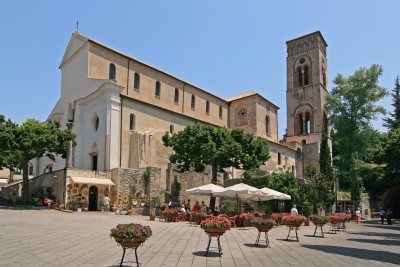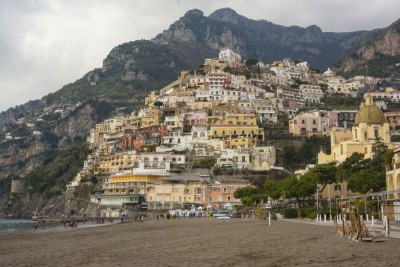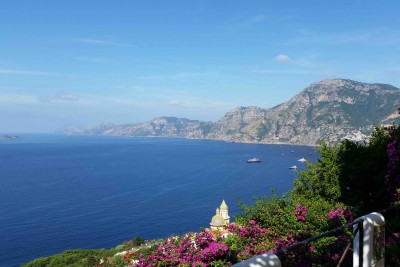Ravello, High Above the Amalfi Coast
An article by Rosemary Zibart published on May 19th, 2002 by the Santa Fe New Mexican

If you ever wondered where D.H. Lawrence penned Lady Chatterley's Lover or where Richard Wagner was inspired to compose Parsifal, the answer is Ravello, a small medieval village perched on a mountain high above the sun-drenched Amalfi coast. And it's every bit as alluring today as it was to the melancholy geniuses who frequented it a century ago.We found Ravello at the tail end of the usual sightseeing stamina race starting in Rome, traversing Naples and concluding at the awesome Pompeii. Determined to give ourselves a few days of calm before returning to the United States, I booked a room at Hotel Toro, which promised -- among other things -- a lovely garden. The hotel also advertised that the Norwegian composer E. Grieg and the German artist M.C. Escher had stayed there. I envisioned myself recuperating from days of frenzied sightseeing, drawing inspiration from the serenity and sunshine ... perhaps even writing a few poetic lines. The name Ravello derives from the word "rebel" and refers to a history of conflict beginning after the area was populated, in the fifth and sixth centuries, by aristocrats fleeing the sack of Rome. They established fortified homes or castles on the mountain precipices above the Republic of Amalfi, which was already a prosperous port. Dissent with the coastal Amalfians provoked those inhabiting these high fortresses to revolt and form their own town. Ravello obviously prospered during the Middle Ages because it sustained enough churches and stores for 30,000 inhabitants. Trade transpired from the rich farming interior to ports as distant as Sicily and the Orient. As a result, some of Ravello's medieval architecture is Moorish in character. Its commercial success was long past, however, when the picturesque town was rediscovered in the 19th century by wealthy English and Americans doing the Grand Tour of Europe. Since then, it's become a popular tourist destination for all nationalities.Although the town is host to at least a dozen hotels of varying grades, we were quite content at the Hotel Toro. Our room, located down a flight of steps with a low sloping ceiling, looked as if it had been transformed from a wine cave. Upon opening the window, we viewed a lemon tree covered with large yellow fruit and draped with a net. The image looked like the sort of picture postcard you buy when you're dreaming of Italy but can't quite manage a trip.While the garden turned out to be as lovely and alluring as promised, we decided to wait until we'd explored the neighborhood. This requires good knees because you're either walking directly up or down. On one jaunt we ran into an Englishman and his wife, both well equipped with walking gear. It turned out that he wrote a book on the footpaths of the Amalfi coast, which we later discovered is valuable information as not all paths lead where you suppose they're going.We started down one steep trail, actually a sort of stone staircase set in the mountainside between terraced plots of carefully tended grape vines, lemon, fig and olive trees, herbs, rose bushes and little vegetable gardens. The walk -- or maybe I should say the hike -- was remarkably beautiful and fragrant. The steps didn't lead all the way down to the coast, however, and we ended up walking on the road for the final leg of our trip down to the water's edge.Enroute, however, we looked up and saw the Villa Cimbrone, a beautiful spot we had previously visited. The Cimbrone consists of a house and extensive garden that were renovated in the late 19th century by an Englishman, Lord Grimthorpe, who "fell desperately in love" with the property, according to the guide book. Touring the garden, one can imagine languorous English travelers idling their time away, like like D.H. Lawrence, who left this verse near a stone bench:"Lost to a world in which I crave no partI sit alone and commune with my heartPleased with my little corner of the earthGlad that I came not sorry to depart."Apparently, Lord Grimthorpe wasn't the only one to find love at the Villa Cimbrone. According to another inscription, it served as a romantic getaway for actress Greta Garbo in the summer of '38.Viewing the Villa Cimbrone from the trail below, you can also see a large contemporary palazzo, perched alongside on the mountainside, which reputedly belongs to the American writer Gore Vidal, now happily retired in Ravello.We continued descending until we reached the base of the mountain at Atrani, a seaside village consisting of whitewashed apartments set into the mountainside. With paint peeling from the stucco, laundry hung out to dry and children playing tag in the courtyards, we decided Atrani resembled the Italy of early Sophia Loren movies. Plus the price of pizzas is well below that of Ravello or Amalfi!
This article, by Rosemary Zibart, was published on May 19th, 2002 in the Santa Fe New Mexican





